Advertisements
Advertisements
प्रश्न
A light ray is incident normally on the face AB of a right-angled prism ABC (μ = 1.50) as shown in figure. What is the largest angle ϕ for which the light ray is totally reflected at the surface AC?

उत्तर
Given,
Refractive index (μ) of prism = 1.50
Let us take θc as the critical angle for the glass.
So, According to Snell's law,
\[\frac{\sin \theta_c}{\sin 90^\circ } = \frac{1}{\mu}\]
\[\Rightarrow \sin \theta c = \frac{1}{1 . 5} = \frac{2}{3}\]
\[\Rightarrow \theta_c = \sin^{- 1} \frac{2}{3}\]
Condition for total internal reflection: 90° − \[\phi\] θc
⇒ \[\phi\] < 90° - θc
\[\Rightarrow \theta_c = \sin^{- 1} \frac{2}{3}\]
\[\Rightarrow \phi < \cos^{- 1} \left( \frac{2}{3} \right)\]
Hence, the largest angle for which light is totally reflected at the surface AC is \[\cos^{- 1} \left( \frac{2}{3} \right)\]
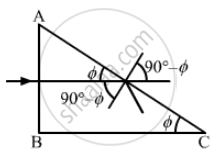
APPEARS IN
संबंधित प्रश्न
Calculate the distance of an object of height h from a concave mirror of radius of curvature 20 cm, so as to obtain a real image of magnification 2. Find the location of the image also.
a) Give two reasons to explain why reflecting telescopes are preferred over refracting type.
Use the mirror equation to deduce that an object placed between the pole and focus of a concave mirror produces a virtual and enlarged image.
Define the term 'limit of resolution'?
Mark the correct options.
Which of the following (referred to a spherical mirror) do (does) not depend on whether the rays are paraxial or not?
(a) Pole
(b) Focus
(c) Radius of curvature
(d) Principal axis
A light ray falling at an angle of 45° with the surface of a clean slab of ice of thickness 1.00 m is refracted into it at an angle of 30°. Calculate the time taken by the light rays to cross the slab. Speed of light in vacuum = 3 × 108 m s−1.
Find the angle of deviation suffered by the light ray shown in figure. The refractive index μ = 1.5 for the prism material.
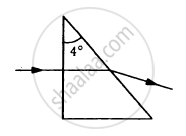
Write any one use for each of the following mirrors :
(a) Convex
(b) Concave
Name the physical principle on which the working of optical fibers is based.
The figure below shows the positions of a point object O, two lenses, a plane mirror and the final image I which coincides with the object. The focal length of the convex lens is 20 cm. Calculate the focal length of the concave lens.
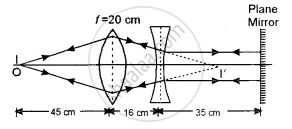
A point object is placed at a distance of 20 cm from a thin plano-convex lens of focal length 15 cm, if the plane surface is silvered. The image will form at:
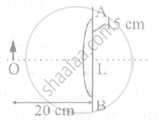
A parallel beam of light is allowed to fall on a transparent spherical globe of diameter 30cm and refractive index 1.5. The distance from the centre of the globe at which the beam of light can converge is ______ mm.
Car B overtakes car A at a relative speed of 40 ms-1. How fast will the image of car B appear to move in the mirror of focal length 10 cm fitted in car A, when car B is 1.9 m away from car A?
Two plane mirrors are inclined at an angle of 40°. The possible number of images of an object placed at point P would be?
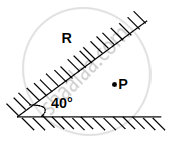
A point object is placed at a distance of 30 cm from a convex mirror of a focal length of 30 cm. What is the separation between the image and the object?
A convex lens of focal length 15 cm is placed coaxially in front of a convex mirror. The lens is 5 cm from the pole of the mirror. When an object is placed on the axis at a distance of 20 cm from the lens, it is found that the image coincides with the object. Calculate the radius of curvature of the mirror - (consider all-optical event):
